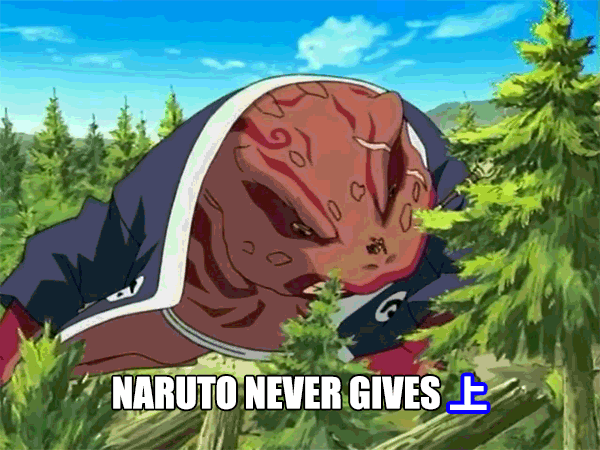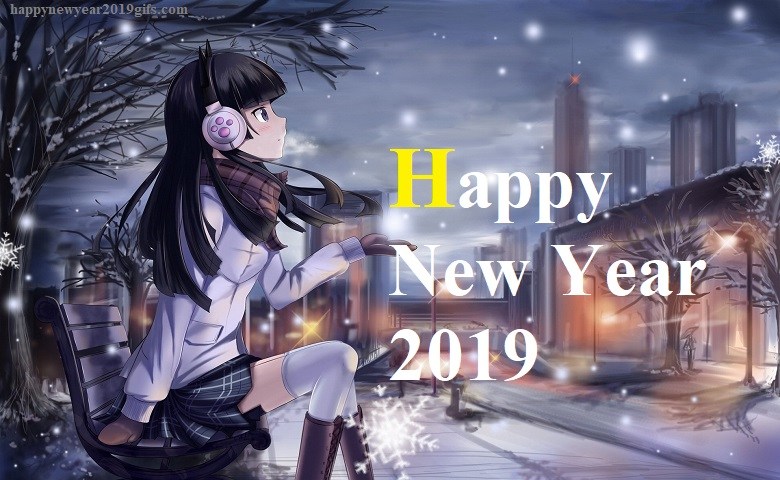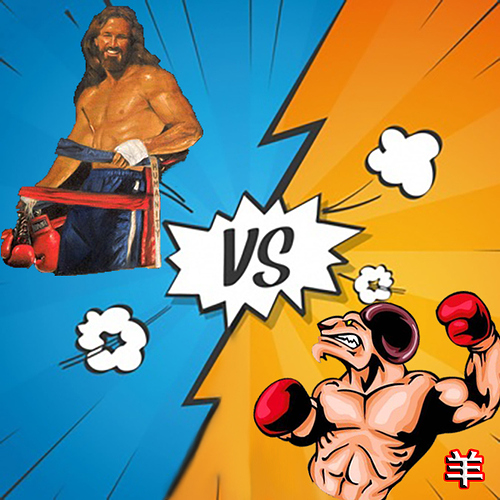You too! ^ _ ^
Happy New Year to everyone! ![]()
This is one I completed a while ago (the last in my stockpile).
羊 - ひつじ - Sheep - Level 6
Vocab Reading = ひつじ
Kanji Reading = よう
( Koichi’s Mnemonic: Imagine a Sheep fighting with Jesus. The first thing it does is hits Jesus (ひつじ) in the stomach with its fists, then hits Jesus again with its horns. Try to imagine this playing out, with an announcer calling the shots as well. )
It felt too weird to actually have a visualization of a sheep hitting Jesus (and it probably couldn’t anyway ![]() ), so I settled on this:
), so I settled on this:

And in case anyone was wondering, it’s just an exhibition bout for charity, purely for fun! ![]()
Vocab - Meaning & Reading
Kanji - Meaning & Reading
Author: Aikibujin
Update:
I added a bit in the OP about many of the mnemonics listed being from before the Great WK Purge.
I also added tags to the visualization links in the OP showing what realm of fandom inspired the visualization.
^ _ ^
From previous thread:
This one uses mnemonics from the Past…
去 - きょ - Past - Level 4
( Koichi’s Old Mnemonic: A pile of graves has a whole lot of past associated with it, and not much future.
To remember the reading きょ, we’ll use “Little Kyoto”. This will differentiate きょ from きょう, which is regular sized Kyoto. Get it? Okay, so all these tombstones from the past are located in Little Kyo to (きょ). Each grave pile represents a Japanese immigrant that came to Little Kyoto and died ![]()
Alternatively, the reading can be こ as well. Just like Little Kyoto is a little Kyoto, it is also a child kyoto, like a 子 Kyoto, making it こ as well. )
( Visualization explanation: Little Kyoto was actually crazy little. All these Japanese immigrants were smaller than a thumb, that’s why they had to move to Little Kyoto. Unfortunately children (こ) thought it would be fun to dance on their city like they were giant monsters from the movies, leaving nothing, but a pile of graves . )
Dedicated to @AnimeCanuck ^ _ ^

If you want to update the mnemonics you could say that the babies are stomping on Little Kyoto (きょ), because they thought it was their Private DIrt, otherwise known as a sandbox…
So in the Past you had Little Kyoto, but after the babies smashed it they had to rebuild and decided to make it bigger.
Alternately you could say someone from Little Kyoto tried to dig up Private Dirt on you from the Past, so of course you sent your giant baby hit squad to smash them! o.O
Kanji - Meaning & Reading
Author: Aikibujin
Still working on yours…
Unfortunately, it won’t be anywhere near as impressive as the time put into it would indicate, I’m simply doing a compilation of clips from a lot of different scenes, so I have to scour through a ton of episodes to find the ones I want.
And yeah I could have done what I’m going for a lot simpler and easier, but once I have a vision, it must be realized!

Don’t worry! And thank you immensely for doing this! ![]()
I can only imagine how troublesome it must be to go through all these eps looking for something specific ![]()
Ultimately my ideas of what the outcome of what I’m making should be, tend to have less effect on the final product than the process itself.
So initially I’ll have an idea of something I want to create, but once I start it, my wants go out the window. The process essentially takes on a life of its own as I continue to do whatever “feels” right from that point on. So by the time it’s done, it could be completely different from what I wanted it to be. And it would drive me crazy to “force” it to be a certain way. I would basically feel like it’s trash when I was done, regardless of how glorious it might be, and just the same I would feel happy with whatever I make if I follow my process properly, regardless of how trash the final product actually is.
Doing these type of projects, especially by request, at least reigns in the process to a degree, as if it doesn’t fulfill the actual goal of visualizing Kanji, then the process wouldn’t feel right anyway, so there’s at least some rails to it that it has to follow. But yes in the end I often end up with a final product that is severely lacking compared to the time, thought, and effort that was actually put into it.
I actually have already tried to do a simplified version of this one three times, and I ended up scrapping them all. As I didn’t want to do another giant three part multi-GIF extravaganza for 1-2 Kanji like I did with Crisis, especially as based on the low number of likes they got, most people didn’t seem to find them very helpful anyway, which is the real point to doing these in the first place…
So yes, one of your requests at least will be a multi-GIF monstrosity, but as long as it helps you, it’ll be worth it. ^ _ ^
That’s really insightful and I’m glad you got to tell me a bit of your process ![]()
Do you work in an art-related field or is it more of a hobby for you?
My ex-boyfriend was an animator, so I understand deeply what’s like to go through what you’ve described. And you’re not alone - everyone goes through that eventually. For what I’ve seen I can tell you this:
Keep on doing projects by request - they do help you with guidelines. And sometimes it’s easier to do something with a purpose than to come up with something entirely new on your own. I think that having these small goals will help you not only with creativity, but also with productivity - specially on the beginning.
Don’t worry that much about time and length. The more you practice, the more you’ll get a feeling for it. If you work with drawing, try using that - you might even consider adding something to your portfolio in the long run.
I really want to thank you for helping me out ![]()
Don’t worry about the final outcome - just knowing you were kind enough to set aside time to pull this off is already more than enough. And, hey, if it helps pushing you through to come up with more art, I’ll keep up the requests, hehe
I have worked in artistic fields, but not currently.
I’m working slowly on a PhD in neuropsychology, so this is currently one of my creative outlets if you will.
I would have had the biggest one I was working on done yesterday, possibly even all of them as I had the day off, but I got lambasted by this thread.
On the upside I posted a lot of my work from the old thread and did some modifications to them to fix broken links and make some of them look a bit more spiffy, so it’ll be less work reposting them here in the future. That said I will likely still make more modifications to them before I repost them here, as many of them I just had to force myself to leave as is, or just make minor adjustments due to time constraints.
No worries. ^ _ ^
This is one I had been working on tentatively in the background for awhile that I finished while doing stuff for the other thread I linked to.
一体 - いったい - The Heck - Level 7



Vocab - Meaning & Reading
Author: Aikibujin
I couldn’t remember the meaning of this one for the life of me. > _ <
Finally got the first one finished!
I’ve been gathering material and working on the others at the same time, so shouldn’t take much longer to complete the rest. ^ _ ^
上がる - あがる - To Rise - Level 1
Koichi’s Mnemonic: This is an intransitive verb. That means it does not take a direct object. The kanji means above so this means something rises. For example: A fever rises. The sun rises. See? No direct object here. That’s why this verb means to rise or to go up.
Dedicated to: @marinauyeda ^ _ ^





Read as: Naruto never gives UP
And あがIN = AGAIN
Vocab - Meaning & Reading
Author: Aikibujin
I also have another three Naruto themed ones that will go along with these.
@dimitri-scripnic @Darcinon
You guys might be interested in them too, though I know at your levels you would have well and truly memorized them by now…
I also entered a lot of these over on this thread:
https://community.wanikani.com/t/wanikani-wednesday-mnemonic-fan-art-contest/34663/22?u=aikibujin
It has many of the old ones I did on the other thread, but cleaned up a bit.
Warning, there’s a boat load of them. ![]()
@Aikibujin I’m sorry it took me a while to answer you - I was away for the weekend.
This is really interesting! ![]()
You’re someone with varied interests, from Japanese, arts and neuropsychology.
Congrats on the PhD, this is a huge accomplishment and I hope things go smoothly for you ![]()
And I just got a look on thread! - I’m cheering for you ![]()
OMG

This mnemonic is perfect, it’s s much easier right now ![]()
Yeah that’s exactly where to post it.
I’ll link it up! ^ _ ^
Glad you like it! ^ _ ^
In theory, all you really need to remember is one of them, then you can extend the rules to the others.
If you know あが is To Rise, it’s not doing it to something else, it’s doing it itself, you can extend that to さが meaning To Get Lower, To Fall, To Hang, it’s doing it itself, not to something else.
So if it ends with あ it does the 上 or 下 on its own, not to something else.
So then flip it around, if the 上 or 下 ends with え then it’s doing it to something else. あげ raises something else and さげ lowers something else (a direct object).
In any case, I do have ones for all four. Here’s the next one:
上げる - あげる - To Raise - Level 1
(Koichi’s Mnemonic: This word consists of kanji with hiragana attached. Because the hiragana ends with an う sound, you know this word is a verb. The kanji itself means above so the verb version of that is when you put something above you. It’s to raise something.
This is a transitive verb. That means it takes a direct object. You raise something. Like your hands!)


Read as: young age
Kanji - Meaning & Reading
Author: Aikibujin



